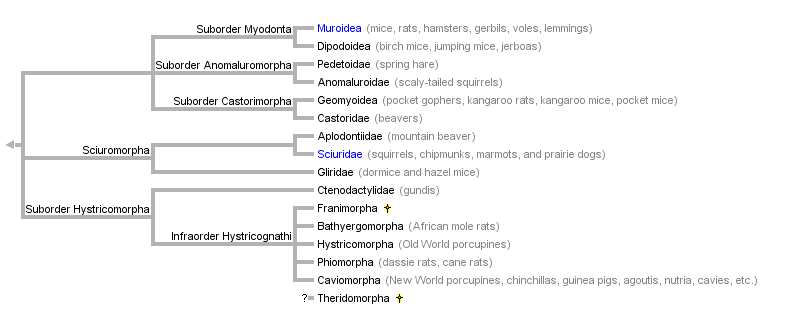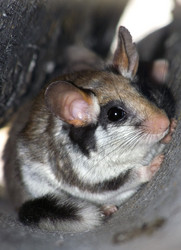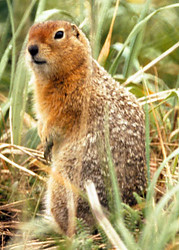Rodentia
Rodents: mice, rats, hamsters, squirrels, gophers, porcupines, beavers, etc.



This tree diagram shows the relationships between several groups of organisms.
The root of the current tree connects the organisms featured in this tree to their containing group and the rest of the Tree of Life. The basal branching point in the tree represents the ancestor of the other groups in the tree. This ancestor diversified over time into several descendent subgroups, which are represented as internal nodes and terminal taxa to the right.

You can click on the root to travel down the Tree of Life all the way to the root of all Life, and you can click on the names of descendent subgroups to travel up the Tree of Life all the way to individual species.
For more information on ToL tree formatting, please see Interpreting the Tree or Classification. To learn more about phylogenetic trees, please visit our Phylogenetic Biology pages.
close boxOther Names for Rodentia
- rodents
- Rodents: mice, rats, hamsters, squirrels, gophers, porcupines, beavers, etc.
References
Allard, M. W., M. M. Miyamoto, and R. L. Honeycutt. 1991. Tests for rodent polyphyly. Nature 353:610-611.
Beintema, J. J., K. Rodewald, G. Braunitzer, J. Czelusniak, and M. Goodman. 1991. Studies on the phylogenetic position of the Ctenodactylidae (Rodentia). Molecular Biology and Evolution 8:151-154.
Cao, Y., J. Adachi, T. A. Yano, and M. Hasegawa. 1994. Phylogenetic place of guinea-pigs - no support of the rodent-polyphyly hypothesis from maximum-likelihood analyses of multiple protein sequences. Molecular Biology and Evolution 11:593-604.
Cao, Y., N. Okada, and M. Hasegawa. 1997. Phylogenetic position of guinea pigs revisited. Molecular Biology and Evolution 14:461-464.
Carleton, M. 1984. Introduction to rodents. Pages 255-265 in Orders and Families of Recent Mammals of the World (S. Anderson and J. K. Jones Jr. eds.) John Wiley and Sons, New York.
Carleton, M. D. and Musser, G. G. 2005. Order Rodentia. Pages 745-752 in Mammal Species of the World, 3rd Ed.
Catzeflis, F. M., J. P. Aguilar, and J. J. Jaeger. 1992. Muroid rodents - phylogeny and evolution. Trends in Ecology & Evolution 7:122-126.
Catzeflis, F. M., A. W. Dickerman, J. Michaux, and J. A. W. Kirsch. 1993. DNA hybridization and rodent phylogeny. PAges 159-172 in Mammal Phylogeny. Volume 2. Placentals. (F. S. Szalay, M. J. Novacek, and M. C. Mc Kenna, eds.) Springer Verlag, New York.
Catzeflis, F. M., C. Hanni, P. Sourrouille, and E. Douzery. 1995. Molecular systematics of hystricognath rodents - the contribution of sciurognath mitochondrial 12s ribosomal-RNA sequences. Molecular Phylogenetics and Evolution 4:357-360.
D'Erchia, A. M., C. Gissi, G. Pesole, C. Saccone, and U. Arnason. 1996. The guinea-pig is not a rodent. Nature 381:597-600.
Flynn, L. J. 1994. Paleontology - roots of rodent radiation. Nature 370:97-98.
Flynn, J. J. and A. R. Wyss. 1998. Recent advances in South American mammalian paleontology. Trends in Ecology and Evolution 13:449-454.
Frye, M. S. and S. B. Hedges. 1995. Monophyly of the order Rodentia inferred from mitochondrial DNA sequences of the genes for 12S ribosomal RNA, 16S ribosomal RNA, and transfer RNA valine. Molecular Biology and Evolution 12:168-176.
Graur, D., W. A. Hide, and W. H. Li. 1991. Is the guinea-pig a rodent? Nature 351:649-652.
Graur, D., W. A. Hide, A. Zharkikh A, and W. H. Li. 1992. The biochemical phylogeny of guinea-pigs and gundis, and the paraphyly of the order Rodentia. Comparative Biochemistry and Physiology B-Biochemistry & Molecular Biology 101:495-498.
Hartenberger, J. L. 1990. The origin of the Theridomyoidea (Mammalia, Rodentia) - new data and hypotheses. Comptes Rendus de l'Academie des Sciences Serie II 311:1017-1023.
Hartenberger, J. L. 1996. The beginning of the adaptive radiation of Rodentia (Mammalia). Comptes Rendus de l'Academie des Sciences Serie II 323:631-637.
Hartenberger, J. L. 1998. Description of the radiation of the Rodentia (Mammalia) from the Late Paleocene to the Miocene; phylogenetic consequences. Comptes Rendus de l'Academie des Sciences Serie II 326:439-444.
Hasegawa, M., Y. Cao, J. Adachi, and T. Yano. 1992. Rodent polyphyly. Nature 355:595.
Huchon, D., F. M. Catzeflis, and E. J. P. Douzery. 2000. Variance of molecular datings, evolution of rodents and the phylogenetic affinities between Ctenodactylidae and Hystricognathi. Proceedings of the Royal Society of London Series B 267:393-402.
Huchon, D., F. M. Catzeflis, and E. J. P. Douzery. 1999. Molecular evolution of the nuclear von Willebrand Factor gene in mammals and the phylogeny of rodents. Molecular Biology and Evolution 16:577-589.
Jacobs, L. L., L. J. Flynn, and W. R. Downs. 1989. Neogene rodents of southern Asia. Pages 157-177 in Papers on Fossil Rodents in Honor of Albert Elmer Wood. ( C. C. Black and M. R. Dawson, eds.) Natural History Museum of Los Angeles County, Los Angeles.
Kramerov, D. A. 1999. The evidence of the close phylogenetic relation between families Gliridae and Sciuridae (Rodenta) based on the study of the short retroposon B1-dID. Doklady Akademii Nauk 364:277-280.
Kramerov, D., N. Vassetzky, and I. Serdobova. 1999. The evolutionary position of dormice (Gliridae) in rodentia determined by a novel short retroposon. Molecular Biology and Evolution 16:715-717.
Lara, M. C., J. L. Patton, and M. N. F. daSilva. 1996. The simultaneous diversification of South American Echimyid rodents (Hystricognathi) based on complete cytochrome b sequences. Molecular Phylogenetics and Evolution 5:403-413.
Li, W. H., W. A. Hide, and D. Graur. 1992. Origin of rodents and guinea-pigs. Nature 359:277-278.
Li, W. H., W. A. Hide, A. Zharkikh, D.-P. Ma, and D. Graur. 1992. The molecular taxonomy and evolution of the Guinea Pig. Journal of Heredity 83:174-181.
Luckett, W. P. and J.-L. Hartenberger (eds.) 1985. Evolutionary Relationships among Rodents. Plenum Press, New York.
Luckett, W. P. and J.-L. Hartenberger. 1993. Monophyly or polyphyly of the order Rodentia: Possible conflict between morphological and molecular interpretations. Journal of Mammalian Evolution 1:127-147.
Martignetti, J. A. and J. Brosius. 1993. Neural BC1 RNA as an evolutionary marker - guinea-pig remains a rodent. Proceedings of the National Academy of Sciences (USA) 90:9698-9702.
Meng, J., A. R. Wyss, M. R. Dawson, and R. J. Zhai. 1994. Primitive fossil rodent from Inner-Mongolia and its implications for mammalian phylogeny. Nature 370:134-136.
Nedbal, M. A., M. W. Allard, and R. L. Honeycutt. 1994. Molecular systematics of hystricognath rodents: Evidence from the mitochondrial 12S rRNA gene. Molecular Phylogenetics and Evolution 3:206-220.
Nedbal, M. A., R. L. Honeycutt, and D. A. Schlitter. 1996. Higher level systematics of rodents (Mammalia, Rodentia): Evidence from the mitochondrial 12S gene. Journal of Mammalian Evolution 3:201-237.
Philippe, H. 1997. Rodent monophyly: Pitfalls of molecular phylogenies. Journal of Molecular Evolution 45:712-715.
Reyes, A., G. Pesole, and C. Saccone. 1998. Complete mitochondrial DNA sequence of the fat dormouse, Glis glis: Further evidence of rodent paraphyly. Molecular Biology and Evolution 15:499-505.
Robinson, M., F. Catzeflis, J. Briolay, and D. Mouchiroud. 1997. Molecular phylogeny of rodents, with special emphasis on murids: Evidence from nuclear gene LCAT. Molecular Phylogenetics and Evolution 8:423-434.
Robinson, M., C. Gautier, and D. Mouchiroud. 1997. Evolution of isochores in rodents. Molecular Biology and Evolution 14:823-828.
S?nchez-Villagra, M. R., O. Aguilera, and I. Horovitz. 2003. The anatomy of the world's largest extinct rodent. Science 301(5640):1708-1710.
Serdobova, I. M. and D. A. Kramerov. 1998. Short retroposons of the B2 superfamily: Evolution and application for the study of rodent phylogeny. Journal of Molecular Evolution 46:202-214.
Tomida, Y., C. K. Li, and T. Setoguchi (eds.) 1994. Rodent and Lagomorph Families of Asian Origins and Diversification. National Science Museum Monographs, No. 8 Tokyo.
Tong, Y. S. and M. R. Dawson. 1995. Early eocene rodents (Mammalia) from Shandong Province, Peoples Republic of China. Annals of Carnegie Museum 64:51-63.
Vucetich, M. G., D. H. Verzi, and J. L. Hartenberger. 1999. Review and analysis of the radiation of the South American Hystricognathi (Mammalia, Rodentia). Comptes Rendus de l'Academie des Sciences Serie II 329:763-769.
Wyss, A. R., J. J. Flynn, M. A. Norell, C. C. Swisher, R. Charrier, M. J. Novacek, and M. C. McKenna. 1993. South America's oldest rodent and recognition of a new interval of mammalian evolution. Nature 365:434-437.
Wyss, A. R. and J. Meng. 1996. Application of phylogenetic taxonomy to poorly resolved crown clades: A stem-modified node-based definition of Rodentia. Systematic Biology 45:559-568.
Information on the Internet
- Rodentia. Animal Diversity Web. University of Michigan Museum of Zoology.
- The Mammals of Texas: Rodents.
- Rodent Genome Databases.
- The Rodent Zone.
- The Squirrel Place.
- International Marmot Network.
- National Gerbil Society (UK).
- The Dormouse Hollow.
- The Capybara Page.
Title Illustrations

| Scientific Name | Eliomys quercinus |
|---|---|
| Location | Valdemorillo, Madrid, Spain |
| Specimen Condition | Live Specimen |
| Source | Eliomys quercinus |
| Source Collection | Flickr |
| Image Use |
 This media file is licensed under the Creative Commons Attribution-NonCommercial-NoDerivs License - Version 2.0. This media file is licensed under the Creative Commons Attribution-NonCommercial-NoDerivs License - Version 2.0.
|
| Copyright | © 2008 Alvaro Oporto |
| Scientific Name | Spermophilus parryii |
|---|---|
| Comments | Arctic ground squirrel |
| Creator | Jim McCarthy |
| Specimen Condition | Live Specimen |
| Source Collection | U.S. Fish and Wildlife Service Online Digital Media Library |
About This Page
Correspondence regarding this page should be directed to Scott J. Steppan at
Page copyright © 2006
All Rights Reserved.
- Content changed 18 April 2006
Citing this page:
Tree of Life Web Project. 2006. Rodentia. Rodents: mice, rats, hamsters, squirrels, gophers, porcupines, beavers, etc.. Version 18 April 2006 (temporary). http://tolweb.org/Rodentia/15959/2006.04.18 in The Tree of Life Web Project, http://tolweb.org/












 Go to quick links
Go to quick search
Go to navigation for this section of the ToL site
Go to detailed links for the ToL site
Go to quick links
Go to quick search
Go to navigation for this section of the ToL site
Go to detailed links for the ToL site